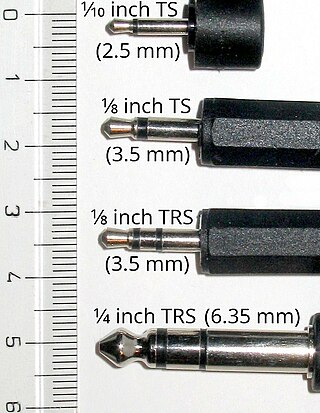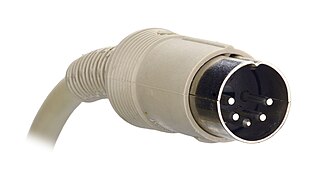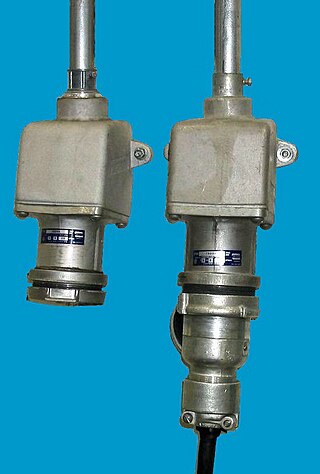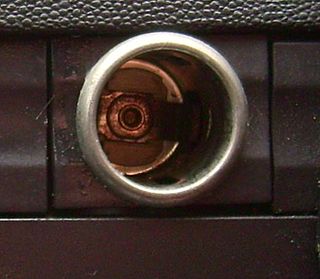




A binding post is a connector commonly used on electronic test equipment to terminate (attach) a single wire or test lead. They are also found on loudspeakers and audio amplifiers as well as other electrical equipment.





A binding post is a connector commonly used on electronic test equipment to terminate (attach) a single wire or test lead. They are also found on loudspeakers and audio amplifiers as well as other electrical equipment.
A binding post contains a central threaded metal rod and a cap that screws down on that rod. Binding posts slowly evolved from 19th century general purpose fasteners into 20th century electrical binding posts. Examples of binding posts used during the 19th century are telegraph key and blasting machine devices.
Caps are commonly insulated with plastic and color-coded: red commonly means an active or positive terminal; black indicates an inactive (reference or return) or negative terminal; and green indicates an earth (ground) terminal. Caps during the 19th century were typically bare metal until synthetic plastic, such as Bakelite, became available in the early 20th century.
During the late 1940s, General Radio created a new binding post that had a jack in a cap. [1] [2] [3] Today it is commonly known as a "five-way" or "universal" binding post, which allows many types of connection methods:

Even so-called isolated binding posts are typically not sufficiently isolated to protect users from coming into contact with their metal parts carrying voltage. As such they are not suitable to be used for carrying dangerous voltages (cf. extra-low voltage). On several types of equipment it has been becoming common to no longer use the traditional binding posts, but safety banana jacks. The universal property of binding posts is lost here, since safety banana jacks can only be used with traditional and safety banana plugs.
In the past, it was common for multiple five-way binding posts to have their drilled holes lined up; this provided convenience in some applications as a bare wire could be strung from post to post to post. But this also impaired safety as two wires or pin connectors could be inserted from opposite sides of two binding posts and the tips of the wires or probes might inadvertently short together. Holes are now normally aligned in such a fashion that such shorts cannot occur.
In order to permit the use of double banana plugs, the most common distance between the centers of the plugs should be 3⁄4 inch (19 mm), which originated on General Radio test equipment during the 1920s, however 3⁄4 inch is not the only spacing.

A breadboard, solderless breadboard, or protoboard is a construction base used to build semi-permanent prototypes of electronic circuits. Unlike a perfboard or stripboard, breadboards do not require soldering or destruction of tracks and are hence reusable. For this reason, breadboards are also popular with students and in technological education.

Components of an electrical circuit are electrically connected if an electric current can run between them through an electrical conductor. An electrical connector is an electromechanical device used to create an electrical connection between parts of an electrical circuit, or between different electrical circuits, thereby joining them into a larger circuit. Most electrical connectors have a gender – i.e. the male component, called a plug, connects to the female component, or socket. The connection may be removable, require a tool for assembly and removal, or serve as a permanent electrical joint between two points. An adapter can be used to join dissimilar connectors.

A phone connector is a family of cylindrically-shaped electrical connectors primarily for analog audio signals. Invented in the late 19th century for telephone switchboards, the phone connector remains in use for interfacing wired audio equipment, such as headphones, speakers, microphones, mixing consoles, and electronic musical instruments. A male connector, is mated into a female connector, though other terminology is used.

A DC connector is an electrical connector for supplying direct current (DC) power.

IEC 60320 Appliance couplers for household and similar general purposes is a set of standards from the International Electrotechnical Commission (IEC) specifying non-locking connectors for connecting power supply cords to electrical appliances of voltage not exceeding 250 V (a.c.) and rated current not exceeding 16 A. Different types of connector are specified for different combinations of current, temperature and earthing requirements. Unlike IEC 60309 connectors, they are not coded for voltage; users must ensure that the voltage rating of the equipment is compatible with the mains supply. The standard uses the term coupler to encompass connectors on power cords and power inlets and outlets built into appliances.

The DIN connector is an electrical connector that was standardized by the Deutsches Institut für Normung (DIN), the German Institute for Standards, in the mid 1950's, initial with 3 pins for mono, but when stereo connections and gear appeared in late 1950's, versions with 5 pins or more were launched. The male DIN connectors (plugs) feature a 13.2 mm diameter metal shield with a notch that limits the orientation in which plug and socket can mate. The range of DIN connectors, different only in the configuration of the pins, have been standardized as DIN 41524 / IEC/DIN EN 60130-9 ; DIN 45322 ; DIN 45329 / IEC/DIN EN 60130–9 ; and DIN 45326 / IEC/DIN EN 60130-9.

AC power plugs and sockets connect devices to mains electricity to supply them with electrical power. A plug is the connector attached to an electrically-operated device, often via a cable. A socket is fixed in place, often on the internal walls of buildings, and is connected to an AC electrical circuit. Inserting the plug into the socket allows the device to draw power from this circuit.

A banana connector is a single-wire electrical connector used for joining wires to equipment. The term 4 mm connector is also used, especially in Europe, although not all banana connectors will mate with 4 mm parts, and 2 mm banana connectors exist. Various styles of banana plug contacts exist, all based on the concept of spring metal applying outward force into the unsprung cylindrical jack to produce a snug fit with good electrical conductivity. Common types include: a solid pin split lengthwise and splayed slightly, a tip of four leaf springs, a cylinder with a single leaf spring on one side, a bundle of stiff wire, a central pin surrounded by a multiple-slit cylinder with a central bulge, or simple sheet spring metal rolled into a nearly complete cylinder. The plugs are frequently used to terminate patch cords for electronic test equipment such as laboratory power supply units, while sheathed banana plugs are common on multimeter probe leads.

Industrial and multiphase plugs and sockets provide a connection to the electrical mains rated at higher voltages and currents than household plugs and sockets. They are generally used in polyphase systems, with high currents, or when protection from environmental hazards is required. Industrial outlets may have weatherproof covers, waterproofing sleeves, or may be interlocked with a switch to prevent accidental disconnection of an energized plug. Some types of connectors are approved for hazardous areas such as coal mines or petrochemical plants, where flammable gas may be present.

In electrical and mechanical trades and manufacturing, each half of a pair of mating connectors or fasteners is conventionally assigned the designation male or female. The female connector is generally a receptacle that receives and holds the male connector. Alternative terminology such as plug and socket or jack are sometimes used, particularly for electrical connectors.

A Fahnestock clip is an early type of spring clamp electrical terminal for connections to bare wires. It is still used in educational electronic kits and teaching laboratories in schools. It is designed to grip a bare wire securely, yet release it with the push of a tab. The clip was patented in the United States on February 26, 1907 by John Schade Jr., assigned to Fahnestock Electric Co. Less than two weeks after the patent was issued they filed for reissue.

Twist-on wire connectors are a type of electrical connector used to fasten two or more low-voltage electrical conductors. They are widely used in North America and several European countries in residential, commercial and industrial building power wiring, but have been banned in some other jurisdictions.

A speaker terminal is a type of electrical connector often used for interconnecting speakers and audio power amplifiers.

NEMA connectors are power plugs and receptacles used for AC mains electricity in North America and other countries that use the standards set by the US National Electrical Manufacturers Association. NEMA wiring devices are made in current ratings from 15 to 60 amperes (A), with voltage ratings from 125 to 600 volts (V). Different combinations of contact blade widths, shapes, orientations, and dimensions create non-interchangeable connectors that are unique for each combination of voltage, electric current carrying capacity, and grounding system.

A modular connector is a type of electrical connector for cords and cables of electronic devices and appliances, such as in computer networking, telecommunication equipment, and audio headsets.

Tip and ring are the two conductors or sides of a telephone line. Their names are derived from the telephone plugs used for connecting telephone calls in manual switchboards. One side of the line is connected to the metal tip of the plug, and the second is connected to a metal ring behind the tip, separated and insulated from the tip by a non-conducting material. When inserted into a jack, the plug's tip conductor connects first, followed by the ring conductor. In many European countries, tip and ring are referred to as the A and B wires.

An automobile auxiliary power outlet in an automobile was initially designed to power an electrically heated cigarette lighter, but became a de facto standard DC connector to supply electrical power for portable accessories used in or near an automobile directly from the vehicle's electrical system. Such include mobile phone chargers, cooling fans, portable fridges, electric air pumps, and power inverters.

A screw terminal is a type of electrical connection where a wire is held by the tightening of a screw.
Audio connectors and video connectors are electrical or optical connectors for carrying audio or video signals. Audio interfaces or video interfaces define physical parameters and interpretation of signals. For digital audio and digital video, this can be thought of as defining the physical layer, data link layer, and most or all of the application layer. For analog audio and analog video these functions are all represented in a single signal specification like NTSC or the direct speaker-driving signal of analog audio.

MC4 connectors are single-contact electrical connectors commonly used for connecting solar panels. The MC in MC4 stands for the manufacturer Multi-Contact and the 4 for the 4 mm diameter contact pin. MC4s allow strings of panels to be easily constructed by pushing the compatible connectors from adjacent panels together by hand, but require a tool to disconnect them to ensure they do not accidentally disconnect when the cables are pulled. The National Electric Code (NEC) and the UL6703 standard for PV connectors specify that connectors have to be from the same type and brand to avoid the dangers of cross-mating. In addition, IEC 62548 ‘design requirements for PV Systems' require PV connectors to be of the same origin. Originally rated for 600V, newer versions of the MC4 connector are rated at 1500V, which allows longer series strings to be created.
Experimenter - Issue Vol. XXVII, No. 1
Experimenter - Issue Vol. XXVII, No. 2